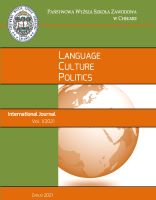Frame Models in Translation: Onomatopea Aspect in Haruki Murakami “Wind-Up Bird Chronicles”
Frame Models in Translation: Onomatopea Aspect in Haruki Murakami “Wind-Up Bird Chronicles”
Author(s): Dariia RzhevskaSubject(s): Language and Literature Studies
Published by: Instytut Neofilologii, Państwowa Wyższa Szkoła Zawodowa w Chełmie
Keywords: conceptual content; onomatopoeia; mimetics; frame; frame model; FrameNet system; adequate translation/ translation techniques; dictionary and contextual equivalents
Summary/Abstract: The article offers an insight into the importance of frames and their features to convey the meaning of Japanese onomatopoeia in the translation process. Based on the present scientific and practical research of the novel by Haruki Murakami “Wind-up Bird Chronicles” and its translation by Jay Rubin, there have been counted frequencies of use along with clarification of the semantic and stylistic peculiarities of onomatopoeia. Frame analysis, which is used to convey the meaning of Japanese onomatopoeia in the context of the English translation, enables to identify the main characteristics of Japanese syntax, especially the use of particles. Since there is no grammar case in Japanese, onomatopoeic verbs are determined by particles, and predicate plays the main role in the sentence structure. In this case, particles may form additional grammar cases. To visualize his inner world, Haruki Murakami uses onomatopoeias that convey emotions and feelings of the protagonist, as well as the descriptions of peculiar features and sounds of nature. It is the presence of mimetics that enables Murakami to create a complex frame net that intertwines the main storylines through the permanent repeating of some onomatopoeia.
Journal: Language, Culture, Politics. International Journal
- Issue Year: 1/2022
- Issue No: 7
- Page Range: 27-36
- Page Count: 10
- Language: English

